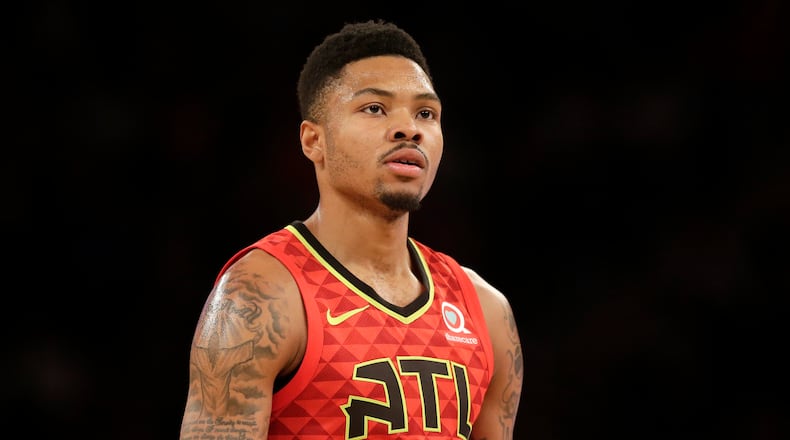Over the next several days I’ll review each Hawks player that was on the roster at the end of the season, in descending order of minutes played.
Previous entries:
After a disappointing performance in 2016-17, Kent Bazemore was much better this season. In terms of Basketball Reference’s Value Over Replacement Player, a box-score metric, Bazemore was as good in 2017-18 as he was in 2015-16.
I wouldn’t go that far because, back then, Bazemore was a key cog on a playoff team. But I’d say Bazemore was the best player on a bad team this season while providing something in terms of leadership. That’s encouraging for the Hawks whether they decide to keep Bazemore around for Year 2 of the rebuild or if they seek value for Bazemore in a trade.
Offensively, the most encouraging developments for Bazemore were rediscovering two aspects of his game that had abandoned him — 3-point shooting and foul drawing— while becoming an even better play-maker.
This season Bazemore made a career-high 39.4 percent of his 3-point attempts on good volume (274 attempts). Bazemore shot 42 percent on catch-and-shoot 3’s (74-for-176) and 47 percent on corner 3’s (40-for-86). Bazemore’s accuracy on catch-and-shoot 3’s ranks 24th-best among all players with at least 1,500 minutes played and 100 attempts. And according to Cleaning the Glass, Bazemore’s shooting percentage on corner 3’s ranked in the 87th percentile among wings.
Bazemore said he was healthy this season after injures nagged him the past couple years and that renewed athleticism showed up in his ability to draw fouls. Bazemore’s free-throw rate (12.4) this season ranked in the 84th percentile among wings, according to Cleaning the Glass. It was Bazemore’s highest free-throw rate since 2014-15 and it came along with a 79.6 percent mark from the line after he shot 71 percent last season.
Bazemore operated as the primary ballhandler frequently this season and had his best year as a play-maker. He posted a 20.1 assist percentage, well higher than his previous season-best of 15.7. The spike wasn’t the result of his bigger role in the offense: Bazemore’s assist to usage rate also was the highest of his career and ranked in the 87th percentile among wings, according to CTG. Bazemore was a legitimate play-making wing this season.
Bazemore was good again on defense this season, when he probably was the team’s best perimeter defender.
Bazemore recorded his highest steal percentage (2.7) since he became a rotation player. He remains an elite shot-blocking wing: 94th percentile in block percentage this season, 85th percentile or higher in each of the three previous seasons. And Bazemore’s 3.7 deflections per 36 minutes ranked tied for seventh-best in the league among players with at last 1,500 minutes, according to NBA tracking stats.
Bazemore’s defensive on-court, off-court numbers agree with the eye test and all the other numbers in categorizing Bazemore as an excellent elite wing defender. Among wings who played at least 40 games and averaged 20 minutes or more, Bazemore ranked 18th in ESPN’s Real Plus-Minus.
Bazemore is a very good defender but he’s not an All-Star caliber player because of his limited offensive game. Despite Bazemore’s great 3-point shooting this season, his points per shot attempt ranked just in the 59th percentile (per CTG) because he struggled to convert shooting at the rim in the midrange. Those have been weaknesses for Bazemore over his entire career so he’s unlikely to get much better at them.
Still, Bazemore’s 3-point shooting this season made him a high-usage wing scoring at above-average efficiency. There’s value in that, especially considering Bazemore’s play-making skills and track record as a defender.
Bazemore’s four-year, $70 million contract previously seemed burdensome for the Hawks once they decided to step back from contending. But, as I’ve noted previously, now that Bazemore had a bounce-back season his deal doesn’t look so bad when you look at what other 3-and-D wings are making. Bazemore’s season ended after 65 games because of a knee injury, and concerns about his durability could hold down his value, but he could be a key piece for a playoff team.
Hawks general manager Travis Schlenk was reluctant to deal Bazemore at the trade deadline because he believes his leadership is needed during the rebuild. Certainly Bazemore was a big reason the Hawks were competitive even as they finished last in the Eastern Conference. But I’m sure Schlenk could find a pretty good trade market for Bazemore if he’s inclined to move him.
About the Author





